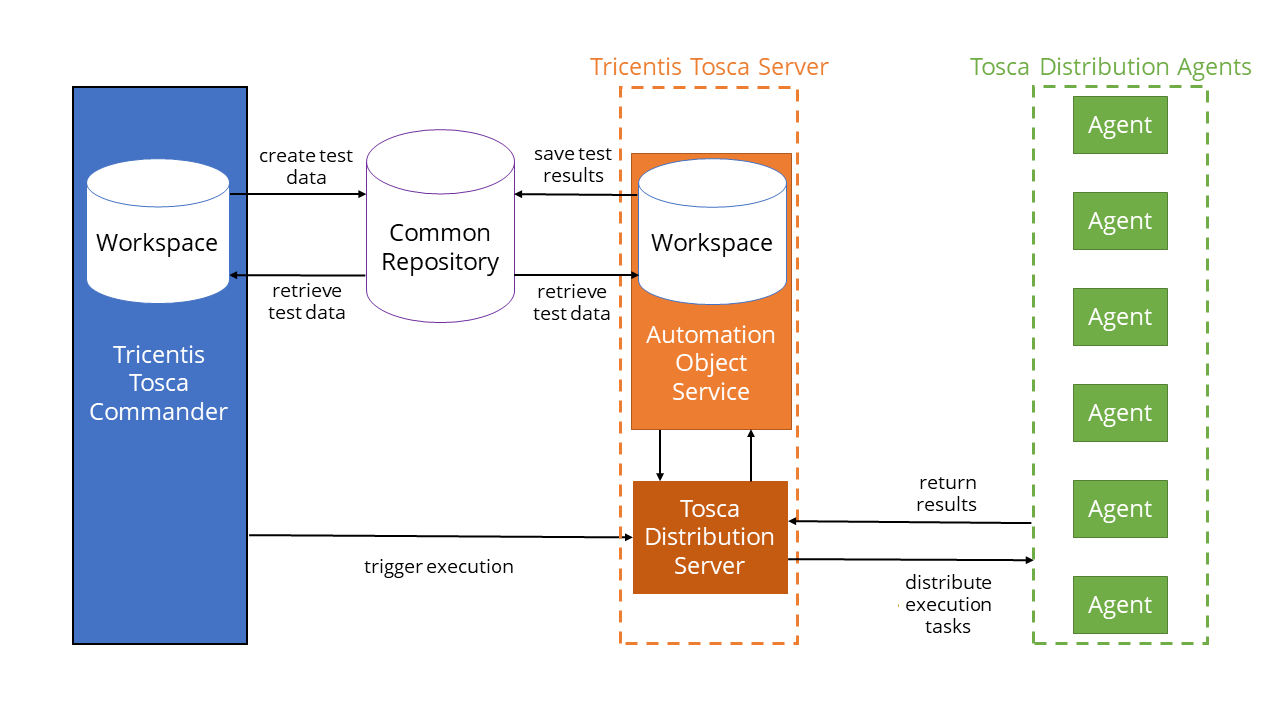Tosca Distributed Execution
When you execute your tests, Tricentis Tosca takes control of your mouse and keyboard, so it can interact with the system under test. Consequently, users can't work on this machine for the duration of the test run. And if you have large test sets, it simply takes too long to run all of them on one machine.
With Tosca Distributed Execution, you can distribute your tests across all available computing resources, such as computers in your network, virtual machines, or the cloud.
This speeds up large test runs and leaves user machines unblocked.
Distributed Execution: main elements
Tosca Distributed Execution is only available for multi-user environments. You and other users share a repository, which stores test data and test results.
Tosca Distributed Execution consists of three main elements:
-
The user machines, where users create tests and trigger the execution.
-
The Tosca Distribution Server, which distributes the tests among the Agents.
-
The Agent machines that execute the tests. Agents save the test results to the common repository.
Setup options
Tricentis offers two main setup options. These options are mutually exclusive; you must choose one or the other.
-
Tosca Distributed Execution with AOS (Automation Object Service)
-
Tosca Distributed Execution without AOS
What's the difference?
The main difference lies with the Agents.
Tosca Distributed Execution without AOS is the legacy option. Each Agent has its own workspace that's connected to the common repository. During execution, Agents query the workspace for items to execute, check them out of the repository, and execute them.

How Distributed Execution without Automation Object Service works
With the newer Tosca Distributed Execution with AOS, Agents work independently of the common repository:
-
They don't have their own workspaces.
-
Their single point of contact to the common repository is the Automation Object Service.

How Distributed Execution with Automation Object Service works
Why Tosca Distributed Execution with AOS?
Tricentis recommends that you use Tosca Distributed Execution with AOS.
-
It's easier to set up. You don't have to configure workspaces on your Agent machines.
-
It's faster. Agents don't have to query a workspace. Moreover, you can run the same ExecutionList in parallel.
-
It can handle multiple repositories.
Switch between setup options
If you're not happy with the setup option that you selected initially, you can switch without losing your common repositories and settings. For more information, see chapter "Switch Distributed Execution options".
Unattended Execution
Unattended Execution is an important component of Tosca Distributed Execution.
It allows you to run tests even if the Agent screen is locked, without a user logged in to the Agent machine. The Tosca RDP Server runs as a service on the Agent machine, and it connects to itself.
If you have graphical user interface (GUI) tests, you must set up Unattended Execution.
Agent types
Tricentis offers the following Agent types:
-
Execution Agent.
This Agent can only execute TestCases created with Engines 3.0.
-
Agent that is a full client installation of Tosca Commander.
This Agent can execute TestEvents created with Classic Engines, Engines 3.0, or both.
Agents: rights and permissions
Agents execute your tests. To do so, the Agent pretends to be a Windows user. This user needs to have access and the necessary permissions for all applications and files that you want to automate.
For instance, if you want to write data to a Microsoft Excel file, the Agent machine must have Microsoft Excel installed. The user must have access to the directory where the file is located and permission to write to the file.
Or if you want to send emails, you need to ensure that your Agent machines and the mail server are able and allowed to communicate via the specified ports.
What's next
Go over our checklist to see if your environment is ready to install and set up Tosca Distributed Execution: "Distributed Execution checklists & best practices".